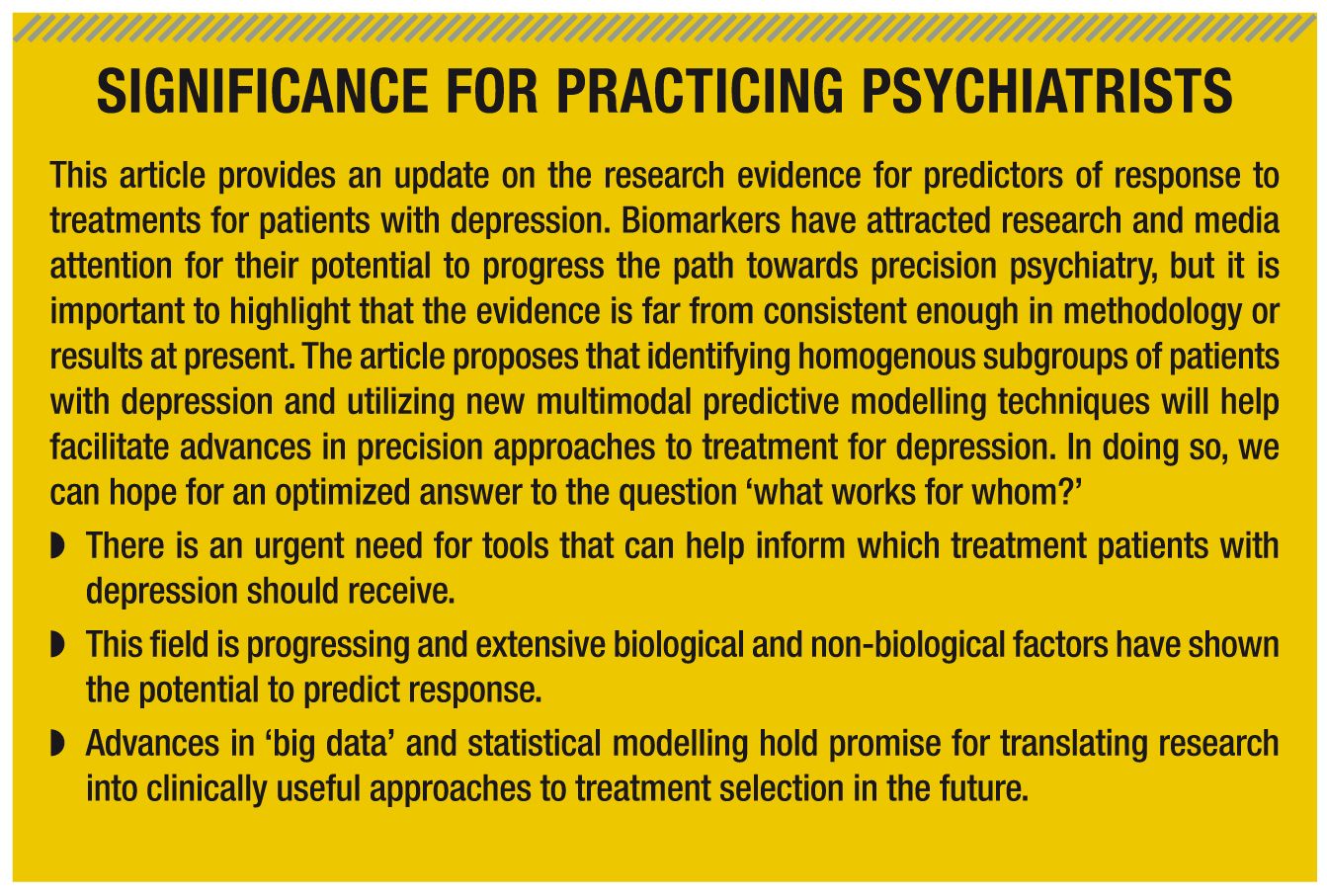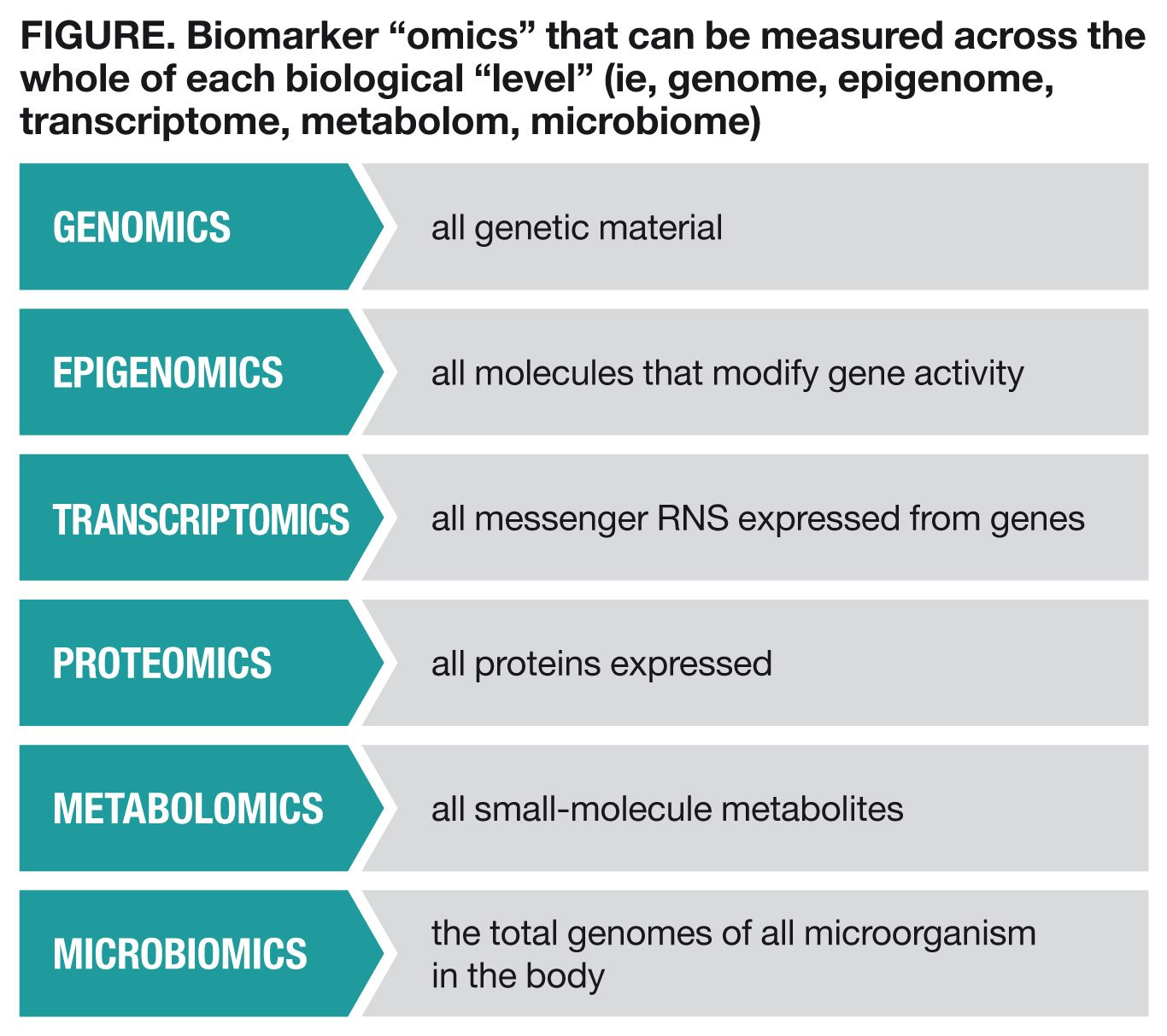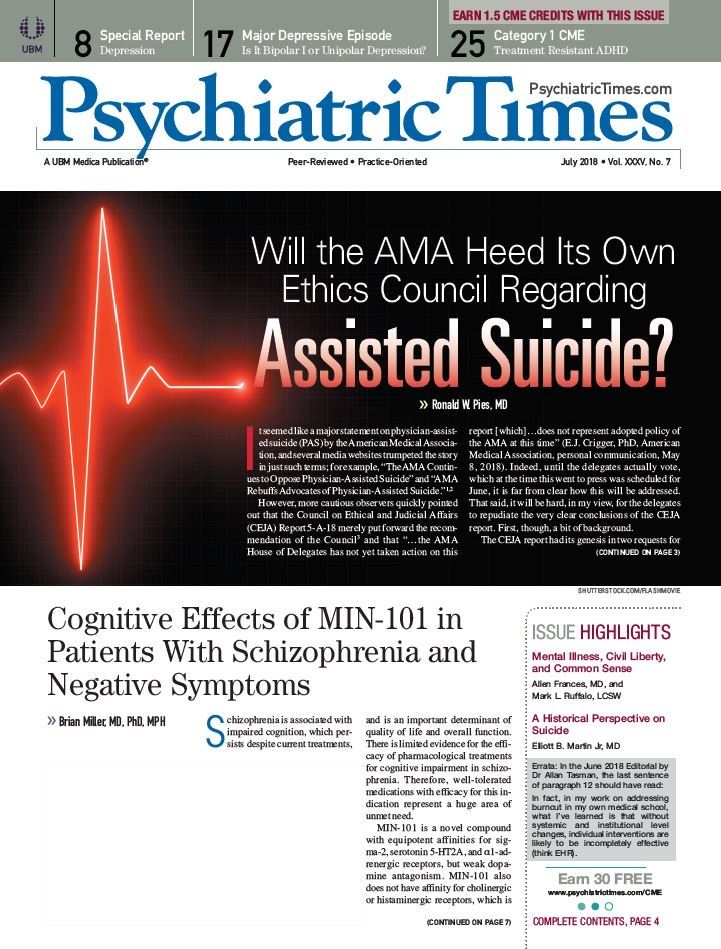Publication
Article
Psychiatric Times
Multimodal Markers and Biomarkers of Treatment
Author(s):
The use of biomarkers to assist with optimizing treatment decisions for depression has been receiving increasing attention. Here is an overview of the challenges and barriers that must be overcome before therapeutic markers can effectively be utilized in practice.
©Hitch/Shutterstock

SIGNIFICANCE FOR PRACTICING PSYCHIATRISTS

FIGURE. Biomarker “omics” that can be measured across the whole of each biological “level”

The emergence of precision approaches to treating depression could hardly be more essential: depression is now deemed to have the highest disability burden worldwide of all illnesses, and inadequate response to treatment compounds the issue.1 A substantial minority of patients experience multiple treatment resistant depression (TRD) and consequential chronic and/or recurrent illness. The burden of TRD is challenging to quantify but extensive, partly due to the associations with increased physical as well as psychiatric morbidity and mortality that in turn present excessive costs to health care and economic sectors, in addition to being detrimental to individual and care-giver wellbeing. Despite this, TRD has received little attention; as a result, treatment guidelines have struggled to provide evidence-based recommendations for TRD, and we are unable to proactively prevent treatment-resistance.2
The field of precision medicine has initiated significant advancements in the treatment of various physical illnesses in recent years.3 Psychiatric research is currently looking at ways to predict response to treatment for a range of disorders including major depressive disorder (MDD) because of the multitude of treatment options and relatively poor response rates to commonly prescribed interventions.
Types of therapeutic markers
The use of biomarkers to assist with optimizing treatment decisions for depression has been receiving increasing attention. Streams of biomarker “omics” may be representative of one or more biological systems and may be measured directly or indirectly in humans. “Omics” describes biomarkers that can be measured across the whole of each level (see Figure). Findings of abnormal genomic, epigenomic, transcriptomic, proteomic, and metabolomic and microbiomic profiles in individuals with psychiatric diagnoses-particularly MDD-have been widespread.4 Although the findings represent potential diagnostic biomarkers, inconsistencies between studies render single biomarkers ineffectual as replacements for current diagnostic tools. Indeed, the potential for a diagnostic biomarker (or biomarkers) for depression are viewed with much skepticism, not least because it is difficult to see how they could ever outperform current diagnostic criteria. For example, neither diagnosis not antidepressant treatment would be recommended for a patient who biologically scored positive for depression but manifested no discernible psychological or functional symptoms.
“Prognostic” biomarkers might be useful for detecting patient vulnerabilities for TRD or chronic depression regardless of which treatment is selected, while “predictive” biomarkers assess the likelihood of success with a specific intervention.5 Both prognostic and predictive therapeutic markers for depression have been explored for a wide variety of biological and non-biological factors.
It is outside the scope of this article to detail which markers in particular can be used as aids for finding optimum treatment strategies for number of reasons: there are too many potential markers; we have not nearly enough evidence or knowledge to make useful prediction estimates; and, it is likely that the most accurate prediction models will be of such considerable complexity that they cannot be practically applied with current approaches. Instead, I first look at a few recent findings that indicate promise for this field and follow with an overview of the challenges and barriers that must be overcome before therapeutic markers can effectively be utilized in practice.
The inflammation revolution
The most widespread biological research in the last decade has focused on inflammation. One of the most striking findings has been regarding macrophage migration inhibitory factor and interleukin-1β (IL-1β) mRNA. Cattaneo and colleagues6 specified cut-off values for biomarker levels; the highest levels were categorized as non-responders. Data showed a positive predictive value and specificity of 100% (as well as negative predictive values of ~85% and sensitivity of ~55%). Following the article release, news reports suggested that a blood test could be used to predict response to antidepressants in this way. This inference was premature inference for a number of reasons: limitations in sensitivity, sample size, and lack of replication.
The findings might be explained by the existence of a modifying factor such as chronicity: elevated IL-1β has been indicated in patients with chronic depressive episodes and high risk for treatment resistant symptoms.7 If these two gene expression markers are established as predictors of escitalopram or nortriptyline response (as Catano et al. found) in future studies, many questions remain; for instance, do these biomarkers represent prescriptive predictors of specific antidepressants or prognostic markers of response regardless of treatment?
Another unanswered question is how gene expression relates to other streams of biomarker (see Figure). Increasing attention is being paid to the microbiome. In support of the findings of Cattaneo and colleagues, elevations in circulating inflammatory proteins have been widely linked to poorer treatment response to various antidepressant treatments but a better response to anti-inflammatory treatments than those with normal inflammatory activity.8,9
It’s not all about inflammation
Promising biomarkers have been posited across a range of biological systems, including neurotransmitter, cell proliferation, and metabolic and endocrine systems (which in themselves operate across omics levels). Cortisol levels could be a prognostic or prescriptive therapeutic marker. Depressed patients with higher levels of cortisol respond less well to psychological (and to serotonergic) therapies than those with lover levels.10 This relationship has not been consistently found in all studies and many other biological markers have predicted response to various treatments for depression (ie, inflammatory cytokines, c-reactive protein, brain-derived neurotropic factor, genetic and other biological markers).
Moreover, numerous nonbiological constructs have preceded poor antidepressant response and have been associated with many biomarkers, such as childhood trauma, personality disorder, psychosocial stress, chronicity and treatment-resistance of depressive illness. Taken together, it appears improbable that a single marker of response to any treatment for depression can be identified without accounting for multiple factors. And modelling these variables together to understand the interactions between treatment mechanisms and outcome is a huge challenge that requires large patient samples and advanced computational models.
The search for homogeneous subtypes
Across biological and non-biological research one factor that is discussed again and again, but has not been fully addressed, is the heterogeneity of depression. One patient can present strikingly differently from another, but on the whole depression is viewed as a single disorder. Despite attempts, clinically homogenous subgroups have not been identified that map onto which treatments people respond to, or even that consistently associate with specific biomarkers, which need to be delineated before therapeutic markers can be established.
Some subtypes have been commonly used such as atypical or melancholic features and these have, to some extent, been linked with biological features: patients with atypical depression may present with attenuated baseline cortisol levels but higher inflammatory activity.11 A somatic subtype may comprise patients with more prominent biological abnormalities, particularly related to inflammation (with prominent symptoms associated with sickness behavior), and this subpopulation might be at increased risk for non-response to monotherapy or low-intensity treatments for depression.9 This may exemplify the need for multimodal modelling of therapeutic markers in depression, specifically through combining clinical and biological factors. As well as proving useful for guiding a precision medicine “what works for whom” agenda, multimodal examination might also help to solve some of the other problems discussed above.
Clinician versus computer: clinical implications
In the absence of precision markers for treating depression, in contrast with a wide array of potential interventions to select from, clinicians are left to use their own clinical insight and intellect (in addition to communication with patients) to select the treatment most likely to achieve remission. This can work well; for example, a specialist national inpatient service in the UK for patients with severe TRD has utilized clinical expertise alongside multidisciplinary treatments to achieve very high rates of treatment response that have been sustained one year after discharge.12 While this indicates that even for complex affective disorders, considering a patient’s illness holistically and insightfully can reach a successful outcome for many individuals, this does not come without significant time investment and domain-specific expertise. Furthermore, findings suggest that statistical models consistently outperform clinical decision making in predicting response.13
Predictive models are not yet sophisticated enough to be clinically useful and statistical modelling has its own challenges, including but not limited to overfitting of data, underpowered sample size, or poor quality data from large studies. Many researchers and clinicians believe that “big data” will catalyze basic science into translational use through mining datasets with large numbers of patients and variables (both biological and nonbiological) and employing machine learning strategies to determine clinically useful algorithms.
What works for whom: a conclusion?
Especially now that exciting undercurrents are beginning to surface, caution is urged. Not only are there thousands of potential therapeutic markers for depression (and more being proposed all the time), these often do not consider clinical heterogeneous presentations. Additionally, there are many putative reasons for non-response to treatments, including inaccurate diagnosis, life events, comorbidities, concurrent treatments, adherence or tolerability issues, duration and dose-related factors, thousands of permutations of depressive symptom combinations (and treatment combinations).
Research on therapeutic markers aspires to facilitate a means of maximizing treatment response early in the course of illness and bring enhanced care to patients more widely, quickly and cheaply. Although this is a noble goal that has the potential to enhance treatment and lessen the burden of this complex illness for many individuals, it is not straightforward: Depression is a complex phenomenon that co-occurs frequently with many diagnoses and for every triumphant anecdote there are a legion of other less-resolved cases.
In order to identify prognostic markers of response to treatment for depression, a multimodal model will almost certainly be required, with its components not yet ascertained. Models of prescriptive markers of response-predicting who will respond well to specific individual treatments-are likely farther away. Extensive work is ongoing in this area, and advancements in prediction modelling will accelerate progress. To accurately answer the question “what works for whom,” we need to maintain hope, patience. and determination.
Disclosures:
Dr Strawbridge is Post-Doctoral Research Associate, Department of Psychological Medicine, Institute of Psychiatry, Psychology & Neuroscience, King’s College London, London, UK.
The author reports no conflicts of interest concerning this article.
References:
1. World Health Organization. Depression Fact Sheet. 2017. http://www.who.int/news-room/fact-sheets/detail/depression. Accessed May 29, 2018.
2. Fekadu A, Donocik JG, Cleare AJ. Standardisation framework for the Maudsley staging method for treatment resistance in depression. BMC Psychiatry. 2018;18:100.
3. National Research Council. Toward Precision Medicine: Building a Knowledge Network for Biomedical Research and a New Taxonomy of Disease. Washington, DC: National Academies Press; 2011.
4. Strawbridge R, Young AH, Cleare AJ. Biomarkers for depression: recent insights, current challenges and future prospects. Neuropsychiatr Dis Treat. 2017;13:1245.
5. Cohen ZD, DeRubeis RJ. Treatment selection in depression. Ann Rev Clin Psychol. 2018;14:209-236.
6. Cattaneo A, Ferrari C, Uher R et al. Absolute measurements of macrophage migration inhibitory factor and interleukin-1-β mRNA levels accurately predict treatment response in depressed patients. Int J Neuropsychopharmaco. 2016;19:pii:pyw045.
7. Anisman H, Ravindran AV, Griffiths J, Merali Z. Endocrine and cytokine correlates of major depression and dysthymia with typical or atypical features. Mol Psychiatry. 1999;4:182.
8. Strawbridge R, Arnone D, Danese A, et al. Inflammation and clinical response to treatment in depression: a meta-analysis. Eur Neuropsychopharmacol. 2015;25:1532-1543.
9. Raison CL, Rutherford RE, Woolwine BJ, et al. A randomized controlled trial of the tumor necrosis factor antagonist infliximab for treatment-resistant depression: the role of baseline inflammatory biomarkers. JAMA Psychiatry. 2013;70:31-41.
10. Fischer S, Strawbridge R, Vives AH, et al. Cortisol as a predictor of psychological therapy response in depressive disorders: systematic review and meta-analysis. Br J Psych. 2016;210:105-209.
11. Lamers F, Vogelzangs N, Merikangas KR, et al. Evidence for a differential role of HPA-axis function, inflammation and metabolic syndrome in melancholic versus atypical depression. Mol Psychiatry. 2013;18:692.
12. Wooderson SC, Fekadu A, Markopoulou K, et al. Long-term symptomatic and functional outcome following an intensive inpatient multidisciplinary intervention for treatment-resistant affective disorders. J Affect Disord. 2014;166:334-342.
13. Grove WM, Zald DH, Lebow BS, et al. Clinical versus mechanical prediction: a meta-analysis. Psychol Assess. 2000;12:19.







